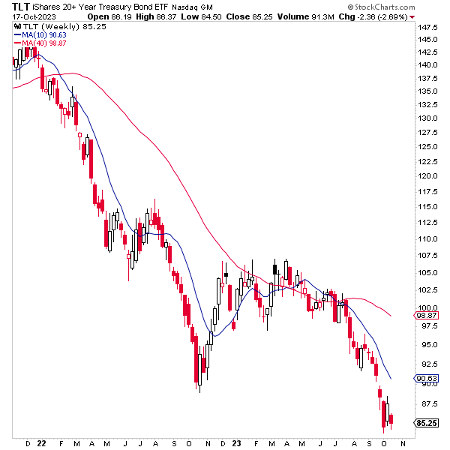
Posted October 18, 2023
By Sean Ring
The Name’s Bond… Treasury Bond.
There are many intelligent people out there touting the return of the treasury bond.
Why? We’ll have to find out.
I’m going to approach this from the skeptic’s point of view.
I’ve hated treasury bonds for a while. And I don’t think the inflation story is over yet. There’s far too much geopolitical instability, especially in the Middle East, to assume oil prices will moderate.
With that said, it’s my job to investigate these things. It may be humbling. It may be confirmatory.
In this Rude, we’ll explore why gentlemen prefer bonds again.
What Are Bonds?
First things first: let's define what a bond is.
There are two ways to think of a bond. The first is that it is a promise. My word is my bond: dictum meum pactum in Latin. That’s been the motto of the London Stock Exchange since 1801.
This saying goes back at least to 1500 when a Scottish source has "O kingis word shuld be o kingis bonde" (A King's word should be a King's bond.)
The second way to think about it is as a tradable loan. The issuer, such as the US Treasury, will issue the bond to investors. Later, investors may choose to trade these bonds with each other to, say, free up cash for a higher-yielding investment or transfer risk.
The ability to trade securities (stocks and bonds) is one of the greatest inventions ever. You’re not stuck with investments anymore. The big caveat is that you may have to sell the securities at a dramatically different (lower) price than you bought them for.
Different Types of Bonds.
U.S. Treasury Bonds
U.S. Department of the Treasury issues treasury bonds (T-bonds), the quintessence of government debt instruments. They come with varying maturities, extending from 20 to 30 years.
Investing in T-bonds is the same as lending money to the federal government, which promises to pay periodic interest and return the principal amount at maturity. The principal is also known as face value. The coupon on the bond is fixed.
Advantages:
Safety: T-bonds are considered among the safest investments as they are backed by the "full faith and credit" of the U.S. government.
Predictable Income: The fixed interest payments provide a steady income stream, making them appealing to risk-averse investors and retirees.
Disadvantages:
Low Yield: Safety comes at the cost of lower yields than other bond types or equities, although yields have increased considerably lately.
Interest Rate Sensitivity: Longer-term bonds like T-Bonds are susceptible to price fluctuations when your Fed Chairman goes overboard during a hiking cycle.
U.S. Savings Bonds
A notch down in complexity are U.S. Savings Bonds, another product of the Treasury Department. These non-marketable bonds can't be sold on the secondary market. There are two primary types: Series EE and Series I, with the latter protecting against inflation.
Advantages:
Affordability: They can be purchased for as low as $25, making them accessible to a broad spectrum of investors.
Tax Advantages: The interest earned is exempt from state and local taxes.
Disadvantages:
Low Yield: Like T-bonds, the returns (yields) are modest.
Lack of Liquidity: A secondary market is necessary to maintain liquidity.
U.S. Investment Grade Corporate Bonds
Shifting the focus to the corporate sphere, corporations with high credit quality issue investment-grade corporate bonds. Rating agencies like Moody's and S&P assess creditworthiness, categorizing bonds as investment grade if rated BBB- or higher.
Advantages:
Higher Yield: They offer better returns compared to government bonds.
Diversification: Adding corporate bonds to a portfolio can provide diversification benefits.
Disadvantages:
Credit Risk: There's a risk that the issuing corporation may face financial hardship, affecting its ability to pay back its debt (and perhaps even the interest payments).
U.S. High Yield Bonds
High Yield Bonds (or junk bonds) are the opposite of investment-grade bonds, bearing a rating of BB+ or lower. Corporations with questionable credit quality issue these bonds, which entail a higher risk.
Advantages:
High Potential Returns: The riskier nature commands higher yields.
Diversification: They can also be a diversification tool, albeit for the more risk-tolerant investor.
Disadvantages:
Credit Risk: The high yield comes with a higher likelihood of default.
Market Risk: These bonds are more susceptible to market fluctuations and economic downturns because they act similarly to equities.
Now that we’ve distinguished between the different types of bonds, let’s look at T-bonds specifically.
Why T-Bonds Are Making a Comeback.
I don’t expect to convince anyone who’s a Doomsday Prepper. But if you think the sun will rise in America in the next few years, you may want to consider this case.

My goodness, it certainly isn’t the technical picture. That chart is uglier than an SBF booty call.
According to my friend and colleague Zach Scheidt:
Now that long-term interest rates have moved sharply higher, investors like you and me can get great discounts buying long-term Treasury bonds.
Most brokerage platforms allow you to buy individual Treasury bonds at current market prices.
He continues:
In the short term, the trend for bond prices is lower. And I don't know how long that will last.
Full disclosure, I personally have a bearish position on long-term bonds as part of my Income Alliance trading program.
This position has been profitable so far as bond prices have been trending lower.
But at this point, we're likely getting close to the end of rate hikes. And sometime in the next two years, we're likely to see rates cut, especially if the broad U.S. economy weakens.
Keep in mind, the U.S. can't afford to keep piling on debt as interest rates rise. So at some point (and relatively soon), there will be political pressure to drive interest rates lower.
My recommendation for a long-term retirement play is to start accumulating some long-term Treasury bonds.
Again, Zach is talking about a long-term play. That means it’s about the income (coupons) you’ll receive and the capital gain you’ll earn over time as the bond “pulls to par.”
Pulling to par is what bonds do when they approach maturity. Say you bought a 30-year t-bond today at a discount (below par) price of 87. You’ll receive the full face value of 100 at maturity in 2053. That means your capital gain over the next 30 years will be 13. Of course, you must believe the USG will still be able to pay its debts by then.
But the ability to pick up 60 coupon payments (US t-bonds pay semiannually) and get your principal back is attractive to certain investors.
Also, if Jay Powell decides to cut rates over the next few years, which he almost certainly will, your bond price will increase in the short term. Bond yields and prices have an inverse relationship: when one goes up, the other goes down.
In fact, the longer you go out on the yield curve - and 30 years is the farthest you can go - the more sensitive your bond’s price will be to moves in yield.
Wrap Up
Zach isn’t the only one who thinks this way. Lance Roberts of Real Investment Advice has published similar pieces.
It’s nice to think you can “set it and forget it.” But I’d caution you about the assumptions you must have to buy 30-year bonds this way.
You’ve got to believe the USG will still be around then. You’ve got to believe we’re at or near the top of the hiking cycle. You’ve got to believe this is the best alternative for your cash.
Food for thought!
I’ll be following up on this in the coming weeks.
In the meantime, have a great day!

And The Queen’s Bank Was No More…
Posted January 16, 2026
By Sean Ring

Passing Notes to Avoid War
Posted January 15, 2026
By Sean Ring

RIP, Scott Adams
Posted January 14, 2026
By Sean Ring

Worldwide Whack-A-Mole
Posted January 13, 2026
By Sean Ring

Powell Subpoenaed For Fed Renovations, Horrifying Wives Everywhere
Posted January 12, 2026
By Sean Ring

